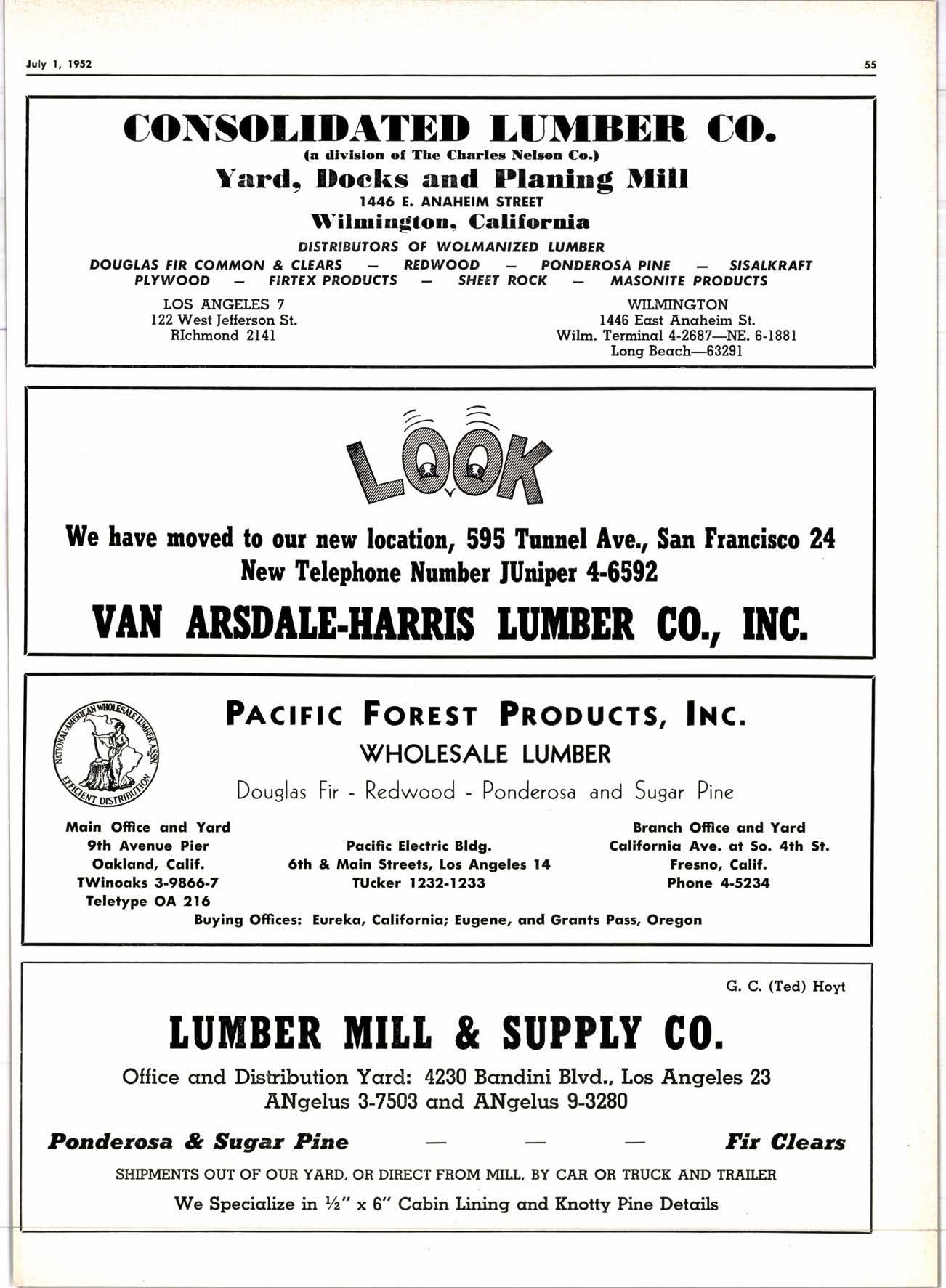
8 minute read
K. WIITSON
company Lumber and their families, over 200 attendCompany u'as the host for the
At the monthly meeting of the San Fernando Lumbermen's Club the following officers rvere elected: President, W. Packman, llammond Lumber Company, Van Nuys; Vice President, T. Nelson, Patten & Davies Lumber Co., Reseda; Secretary-treasurer, Jack H. Fairffield, Hayward l,umber & Investment Co.. San Fernando.
Lumber-Dry and Green is the title of an article appearing in this issue by W. K. Kendrick, sales manager, Valley Lumber Co., Fresno.
The Los Angeles Hoo-Hoo Club initiated nine Kittens at a concatenation staged at the Riva Ranch, Ventura, on Saturday afternoon, June 18. Snark W. B. Wickersham was in charge of the ritual. A barbecue beefsteak dinner rvas served.
Nliss Genevieve Nicholson, daughter of Ed Nicholson, head of the Pacific Sash & Door Co., Los Angeles, and Kenneth L. Shipp, president of the California Builders Supply Co., Oakland were married at the Old Mission Dolores, San Francisco.
Talk on Hardwoods
(Continued from Page 12) example Clear Heart redwood. Firsts, the highest grade established under the rules, and generally not obtainable, only prodtrces lI/12 or 9l-2/3/" clear face cuttings. Therefore, to secure Clear hardrvoods, when they are obtainable, (mostly in small sizes) it is necessary to purchase much larger boalds than the finished sizes required-boards whose defects, rn'hen cut out, rvill produce the smaller clear piece.
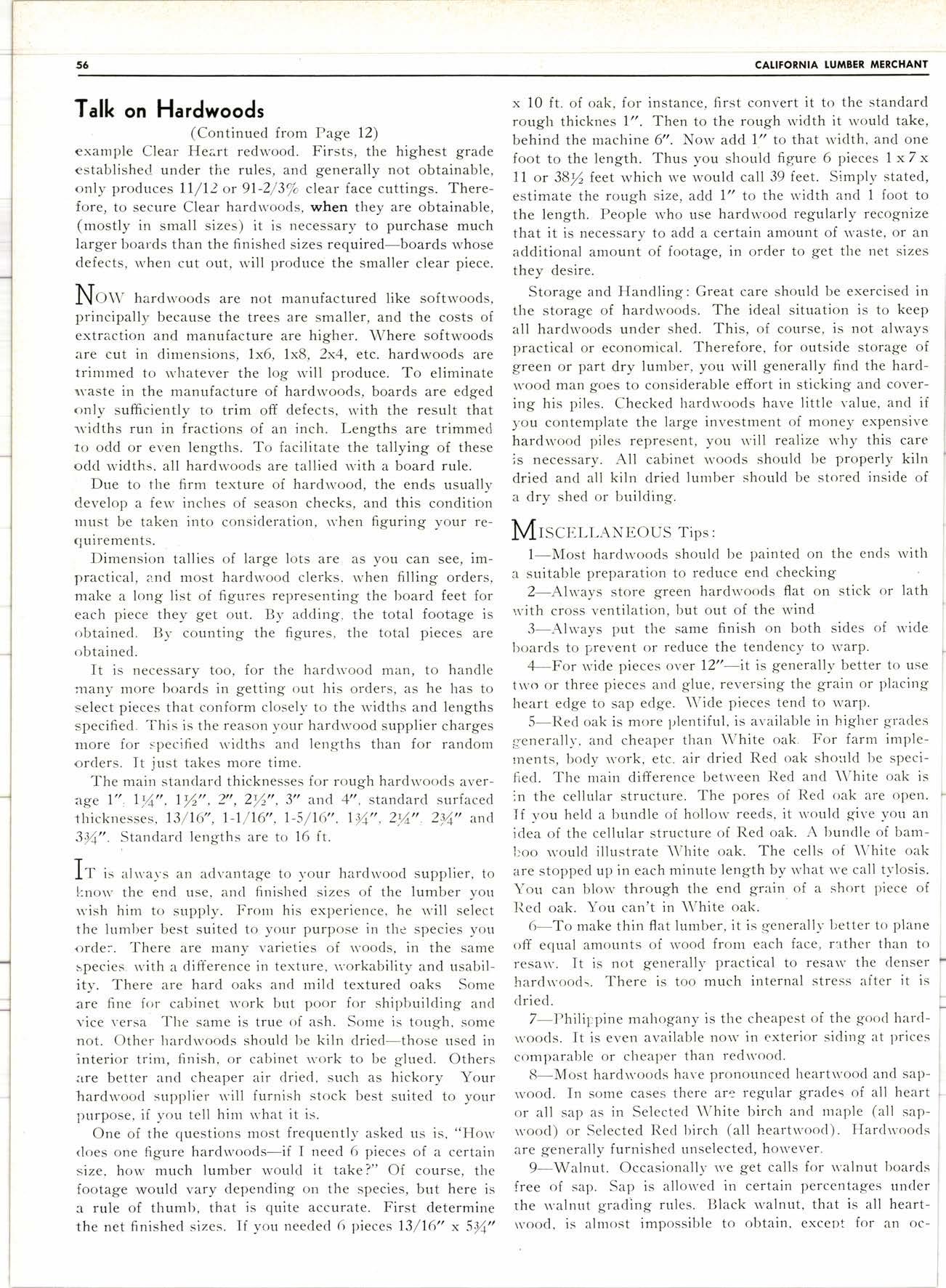
I\T
I\O\\' hardrvoods are not manufactured like softwoods, principally because the trees are smaller, and the costs of extraction and manufacture are higher. Where softwoods are cut in dimensions, 1x6, 1x8, 2x4, etc. hardwoods are trir-nmed to u,hatever the log u'ill produce. To eliminate \\'aste in the manufacture of hardrvoods, boards are edged only sufficiently to trim off defects, n'ith the result that l'idths run in fractions of an inch. Lengths are trimmed to odd or even lengths. To facilitate the tallying of these odd rvidths, all hardwoods are tallied u'ith a board rule.
Due to tl-re firm texture of hardt'ood, the ends usually develop a feu' inches of season checks, and this condition n.rust be taken into consideration, n'hen figuring your requirements.
I)imension tallies of large lots are as you can see, impractical, and most hardrvood clerks. rvhen filling orders, make a long list of figures representing the board feet for each piece they get out. By adding. the total footage is obtained. I}1' counting the figures, the total pieces are
It is necessary too, for the hardu'ood man, to handle inany more boards in getting out his orders, as he has to select pieces that conform closelv to the lr'idths and lengths specified. This is the reason yonr hardu'ood supplier charges more for specified t'idths and ler-rgths than for random orclers. It just takes more time.
The main star-rclard thicknesses for rough hardu'oods average 1". 11,/a",711",2",2f",3" and 4", standard surfaced thic-knesses, 73/16', l-l/16". 7-5/16", |fi", 2,r/a", Z)(" and 394". Standard lengths are to 16 ft.
TIT is ult'a_r's an advantage to your hardr,vood supplier, to knol. the end use, :rn<l finisl-red sizes of the lumber you n'ish him to supply. Fronr his experience, he rvill select the lumber best suited to your purpose in the species you orde:. There are many varieties of n'oods, in the same species. rvith a difference in textnre, t'orkability and usability. There are hard oaks and rnild textured oaks Some are fine fr>r cabinet u'ork brrt poor for shipbuilding and vice versa The same is true of ash. Some is tough, some not. Other hardrvoods should l>e kiln dried-those used in interior trim, finish. or cabinet n'ork to be glued. Others ;rre better and cheaper air dried, such as hickory Your hardu'ood su1>plier u'ill furnish stock best suited to yonr prlrpose, if you tell him what it is.
One of the cluestions most frequently asked us is, "Hou' <loes one figure hardrvoods-if I need 6 pieces of a certain size, hou' much lumber would it take?" Of course, the footage would vary depending on the species, but here is e rule of thumb, that is quite accurate. First determine the net finished sizes. If you needed (r pieces 13/16" * 5%" x 10 ft. of oak, for instance, first convert it to the standard rough thicknes 1". Then to the rough width it rvould take, behind the machine 6". Norv add l" to that l'iclth, and one foot to the length. Thus you should figure 6 pieces 1 x 7 x ll or 381feet which rve would call 39 feet. Simply stated, estimate the rough size, add 1" to the u'idth and I foot to the length. People rvho use hardwood regularly recognize that it is necessary to add a certain amollnt of rvaste, or an additional amount of footage, in order to get the net sizes they desire.
Storage and Handling: Great care should be exercised in the storage of hardr,r'oods. The ideal situation is to keep all hardrvoods under shed. This, of cottrse, is not always practical or economical. Therefore, for outside storage of green or part dry lumber, you rvill generally find the harcl\\'ood man goes to considerable effort in sticking and covering his piles. Checked l.rardlvoods have little value, and if )'ou contemplate the large investment of money expensive hardlvood piles represent, yott t'ill realize 'w'hy this care ;s necessary. A11 cabinet rvoods should be properly kiln dried and all kiln clried lumber should be stored inside of a dry shed or building.
Mrscelr-ANEouS Tips: l-Most hardrvoods shoulcl be painted on the ends rvith a suitable preparation to reduce end checking
2-Allvays store green hardu'oods flat on stick or lath t'ith cross ventilation, but out of the wind
3-Alu'ays put the same finish on both sides of lgide boards to prevent or reduce the tendency to rvarp.
4-For rvide pieces 6vsv llt'-it is generally better to use tu.o or three pieces and glue, reversing the grain or placirlg heart edge to sap edge. \\ride pieces tend to lvarp.
S-Ited oak is more 1.,lentiful, is available in higher gra<les generalll'. and cheaper than \\rhite oak. For farm implelxents, bocly u'ork, etc. air dried Red oak should be specified. The main difference betu.een Red and \\lhite oak is :n the cellular structure. The pores of Retl oak are open. If you held a bundle of hollorv reeds, it s'ould give you an idea of the cellular structure of Red oak. A Jrundle of baml:oo u,ould illustrate \\/hite oak. The cells of \\rhite oak are stopped up in each minute length by rvhat \\'e call t1'losis. You can blou, through the end grain. of a short piece of Iied oak. You can't in White oak.
(r-To make thin flat lumber, it is generalll better to plane off equal amounts of rvood from each face, rather than to resa\\'. It is not generally practical to resan, the clenser hards'oods. There is too much internal stress aiter it is <1ried.
7-Philippine mahogany is the cheapest of the goocl hardu,oocls. It is even available non' in exterior sidirrg at prices comparable or cheal>er than redl'ood.
8-Most hardu'oocls hzn'e pronottnced heartn,ood and sapn'ood. fn some cases there are regttlar grades of all heart or all sap as in Selected \\rhite birch and maple (all sapu'oocl) or Selected Recl birch (all heartn'ood). Hardu'oods are generally furnished tlnselected, hou'ever.
9-Walnut. Occasionally \\,e get calls for u'alnut ltoards free of sap. Sap is allol'ed in certain percentages ttn<ler the u'alnnt grading rules. Black lvalnut, that is all heartn'ood, is alnrost impossible to obtain. excet)t for an oc-
F casional piece or on a long accumulative basis. Most rvalnut !s steamed in rvalnut sawdust, rvhich stains the sapwood, so it does not contrast sharply rvith the heartwood. Walnut tends to run narrow and short. Occasional large clear pieces are almost extinct. lO-Birch can be substituted for walnut or mahogany, r,vhen properly stained. Where price is the factor, magnolia or tupelo make a fair substitute for walnut and mahogany, although there is nothing like the real thing. l2--Horv to specify hardu'oods : l-State number of pieces, lineal feet or board feet required.
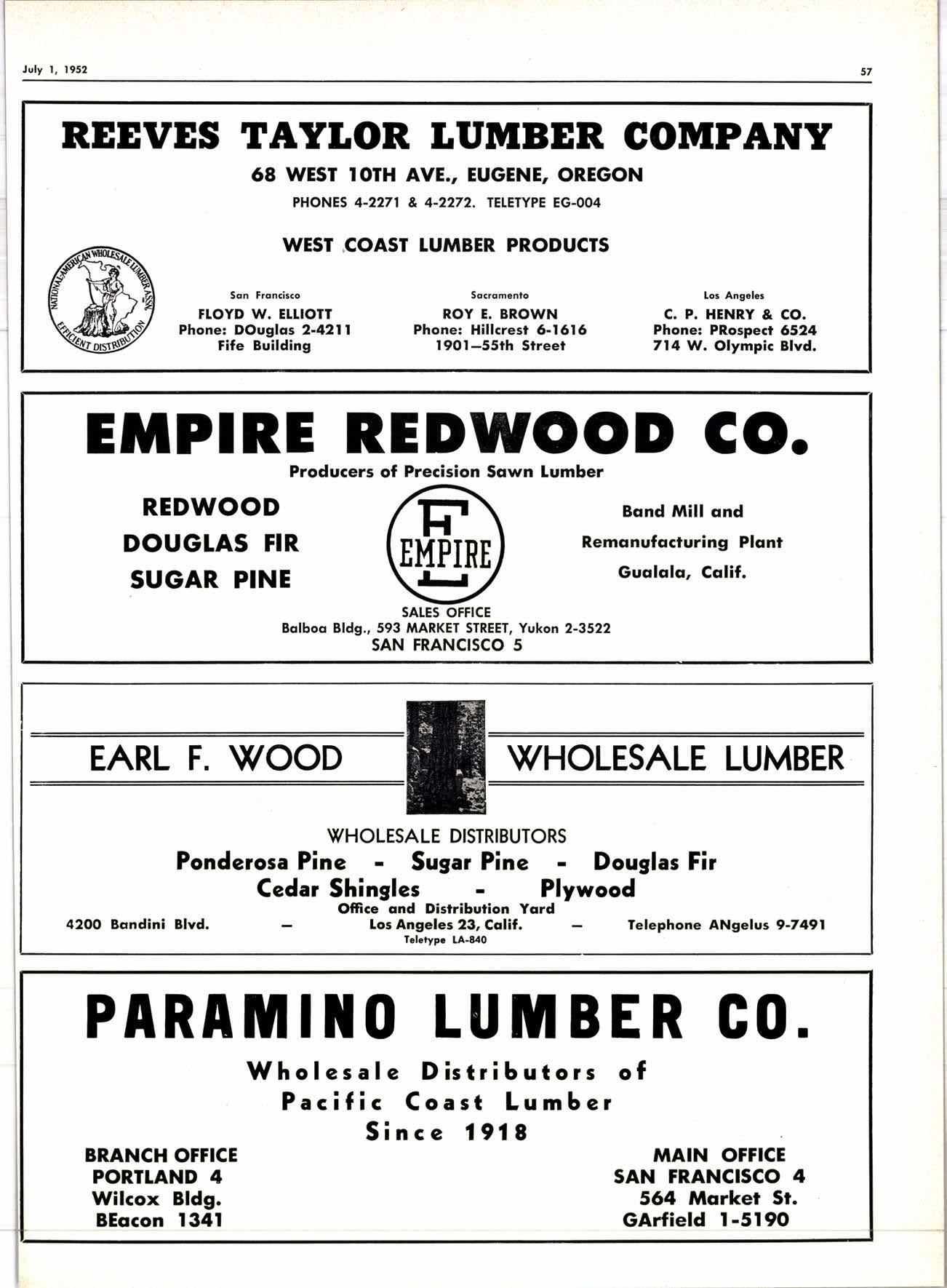
1l-Domestic hardwoods 10" and wider are becoming scarce rvith some exceptions like oak-also are 14 and 16 foot lengths in some woods from certain sections.
Z-Thickness in inches.
3-\\ridth in inches.
4-Length in feet.
S-Name of 'rvood.
6-Whether A.D. or K.D.
7-Whether rough or surfaced. If surfaced whether 1S, 25 or 45. \\rhether sizes are rough or net size after surfacing.
8-\\/hat stock is to be used for.
New Poster Carries Forest Fire Prevention Appeal
T
IN closing, I rvould like to state, that in mv experience, lumbermen by and large are fine people. There is something basic and sound in the industry, and in those who love and l'ork r,vith rvood, and I rvould like to say that I am proud to be a part of the lumber industry, and am happy to have had the opportunity of speaking rvith you fine gentlemen today.
New Lumber Ycrrd West Side Lumber Yard recently opened for business on Highrvay 33 at Third Avenue, Gustine. Calif. Mr. and Mrs. Robert N. Osburn are the owners. Fred Roth, rvell knolr,'n California lumberman, is managing the yard. Modern ecluipment is being used, and plans are being prepared for the building of a u'arehouse to store dry lumL'er and other building materials.
Although old grorvth redwood is less susceptible than rnost species to forest fires, it can nevertheless be badly damaged .rnd young grorvth completely destroyed by flame.
During fire season, logging to have a rvatchman on duty crew has left the u-oods.
Nervest display piece in the forest ir-rdustries educational campaign to prevent l'oocls fires and l{eep America Green is this dramatic four-color l)()ster norv availahle in 25 x 4o-inch size.
The headline "Are You Guilty?" drives home the point lhat forest fire prevention is the personal responsibility of every good American. Copies of the poster norv are availi.ble to schools and other users for display in public places. liecluests should be addressed to American Forest Products Industries, Inc., 1319 E,ighteenth Street, N. W. Washington 6, D. C.
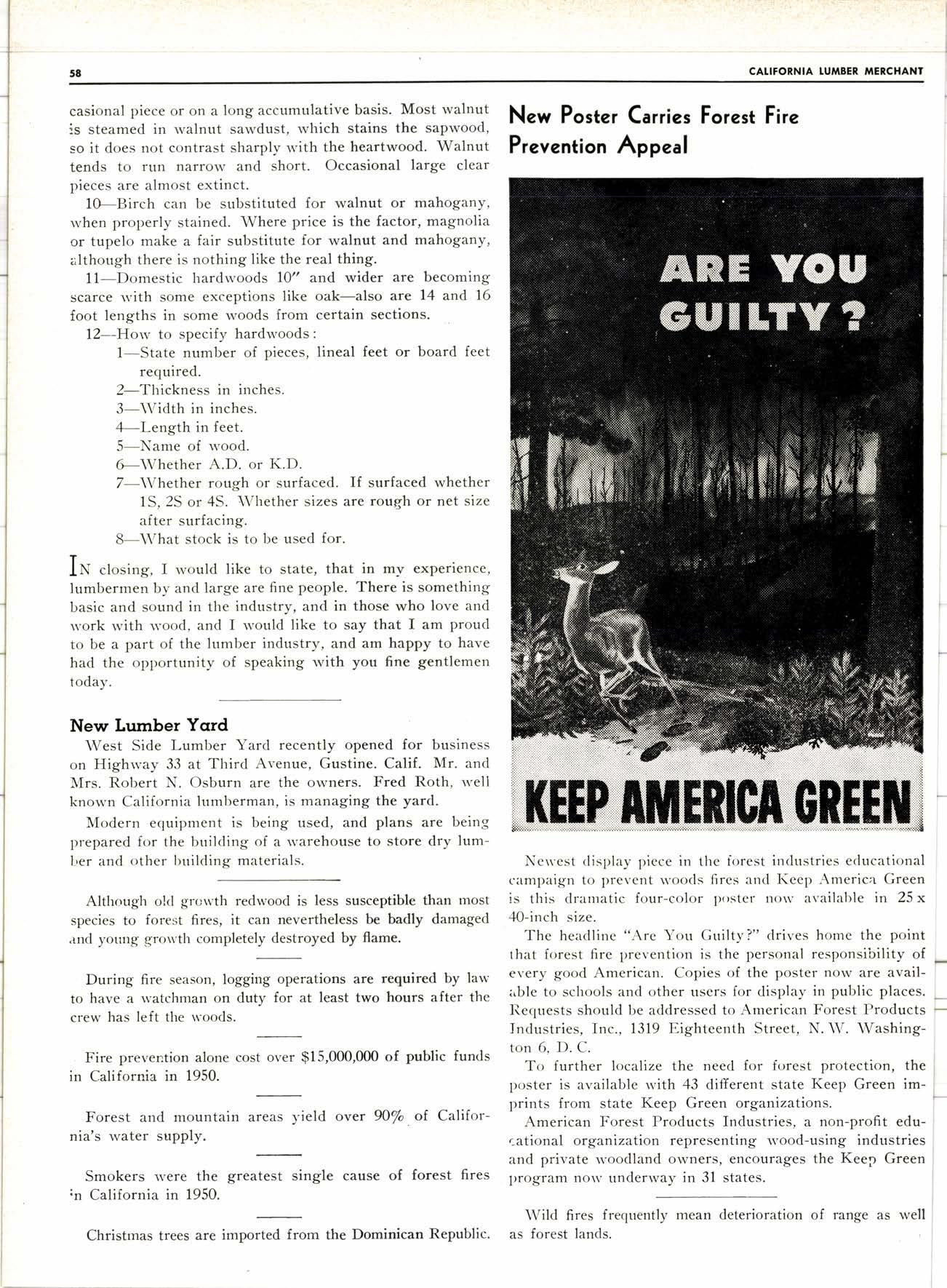
Fire prevention alone cost over $15,000,000 of public funds in California in 1950.
Forest and mountarn nia's water supply.
Smokers u'ere the :n California in 1950.
Christrnas trees are operations are required by larv for at least two hours after the areas yield over 90/o of Califor-
Greatest Single Cause Of Forest Fires
To further localize the need for forest protection, the poster is available rvith 43 different state Keep Green imprints from state Keep Green organizations.
American Forest Products Industries, a non-profit edu.-ational organization representinglvood-using industries and private rvoodland owners, encourages the Keep Green program norv underrvay in 31 states.
Wild fires frequently mean deterioration of range as well the Dominican Republic. as forest lands. imported from
Los Angeles Home Show Aug. 22-Sept. 1
The Torvn and Country, a 1565 square-foot model home designed in California Contemporary farm style, will be one of the top features of the 1952 Home Shorv at Hollyrvood Park August 22 through September 1.
J. A. Por,vers, president of the seventh annual construction industries exposition, r'r'hich the past tu'o years has attracted more than 400,000 persons, said that the Torl'n lnd Country is to be built expressly for the Home Sl-row by the Superior Building Company, Albert Gersten and Niyron P. Beck in charge. Architect for the colorful model home is Paul J. Duncan, A.I.A., rvhose plan for designing the house rvas guided on the principle of "making it an expression of the major n,ants of the buying public."
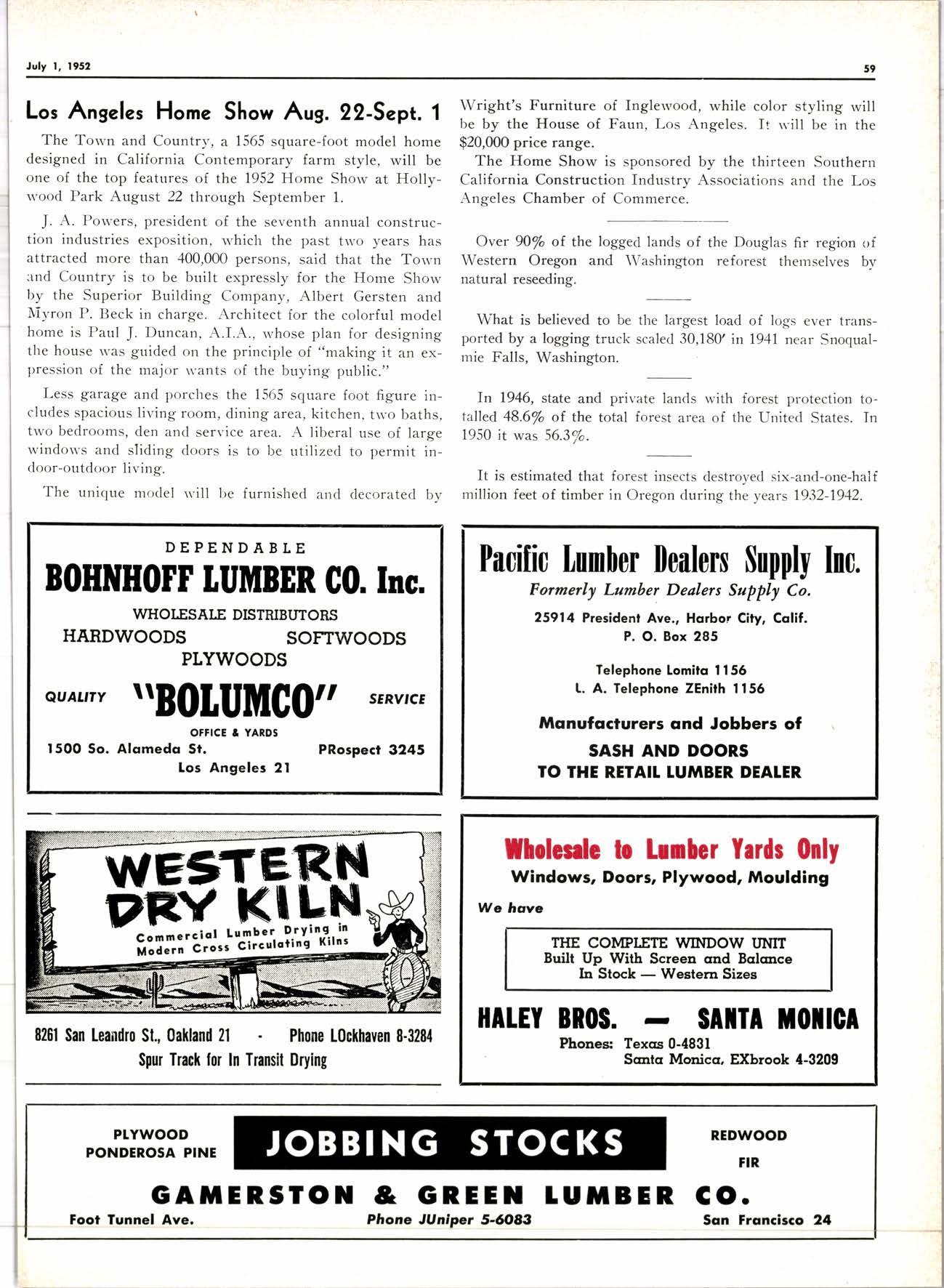
Less garage and porches the 1565 square foot figure includes spacious living room, dining area, kitchen, two baths, tr,vo bedrooms, den ancl service area. A liberal use of large rvindorvs and sliding doors is to be utilized to permit indoor-outdoor living.
The unique moclel rvill be furnished and decorated by the Douglas fir region reforest ther.nselves of by the largest load of logs ever transscale<l 30,180' in 1941 near Snoctual-
Wright's Furniture of Inglervood, while color styling rvill be by the House of Faun, Los Angeles. It .rvill be in the $20,000 price range.
The Home Show is sponsored by the thirteen Southern California Construction Industry Associations ar.rd the Los Angeles Chamber of Commerce.
Over 9O/o of the logged lands of Western Oregon and Washington natural reseeding.
What is believed to be ported by a logging truck rnie Falls, Washington.
In 1946, state and private lands with forest protection totalled 48.6/o of the total forest area of the Urrited States. In 1950 it was 56.3/o.
It is estimated that forest insects destroyed six-and-one-half rnillion feet of timber in Oregon during the years 1932-1912.










